Page 41 of 54
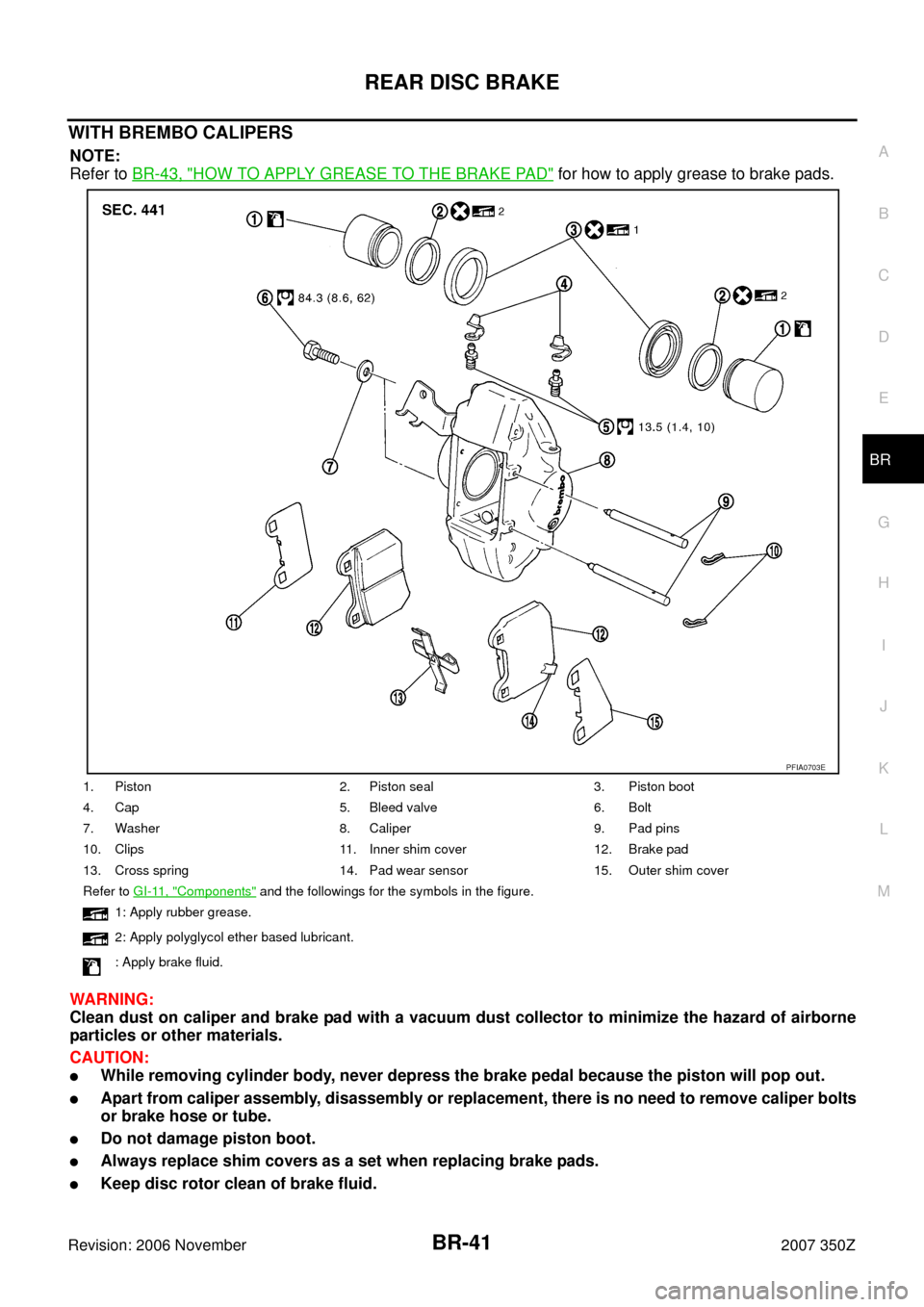
REAR DISC BRAKE
BR-41
C
D
E
G
H
I
J
K
L
MA
B
BR
Revision: 2006 November2007 350Z
WITH BREMBO CALIPERS
NOTE:
Refer to BR-43, "
HOW TO APPLY GREASE TO THE BRAKE PAD" for how to apply grease to brake pads.
WARNING:
Clean dust on caliper and brake pad with a vacuum dust collector to minimize the hazard of airborne
particles or other materials.
CAUTION:
�While removing cylinder body, never depress the brake pedal because the piston will pop out.
�Apart from caliper assembly, disassembly or replacement, there is no need to remove caliper bolts
or brake hose or tube.
�Do not damage piston boot.
�Always replace shim covers as a set when replacing brake pads.
�Keep disc rotor clean of brake fluid.
1. Piston 2. Piston seal 3. Piston boot
4. Cap 5. Bleed valve 6. Bolt
7. Washer 8. Caliper 9. Pad pins
10. Clips 11. Inner shim cover 12. Brake pad
13. Cross spring 14. Pad wear sensor 15. Outer shim cover
Refer to GI-11, "
Components" and the followings for the symbols in the figure.
1: Apply rubber grease.
2: Apply polyglycol ether based lubricant.
: Apply brake fluid.
PFIA0703E
Page 45 of 54
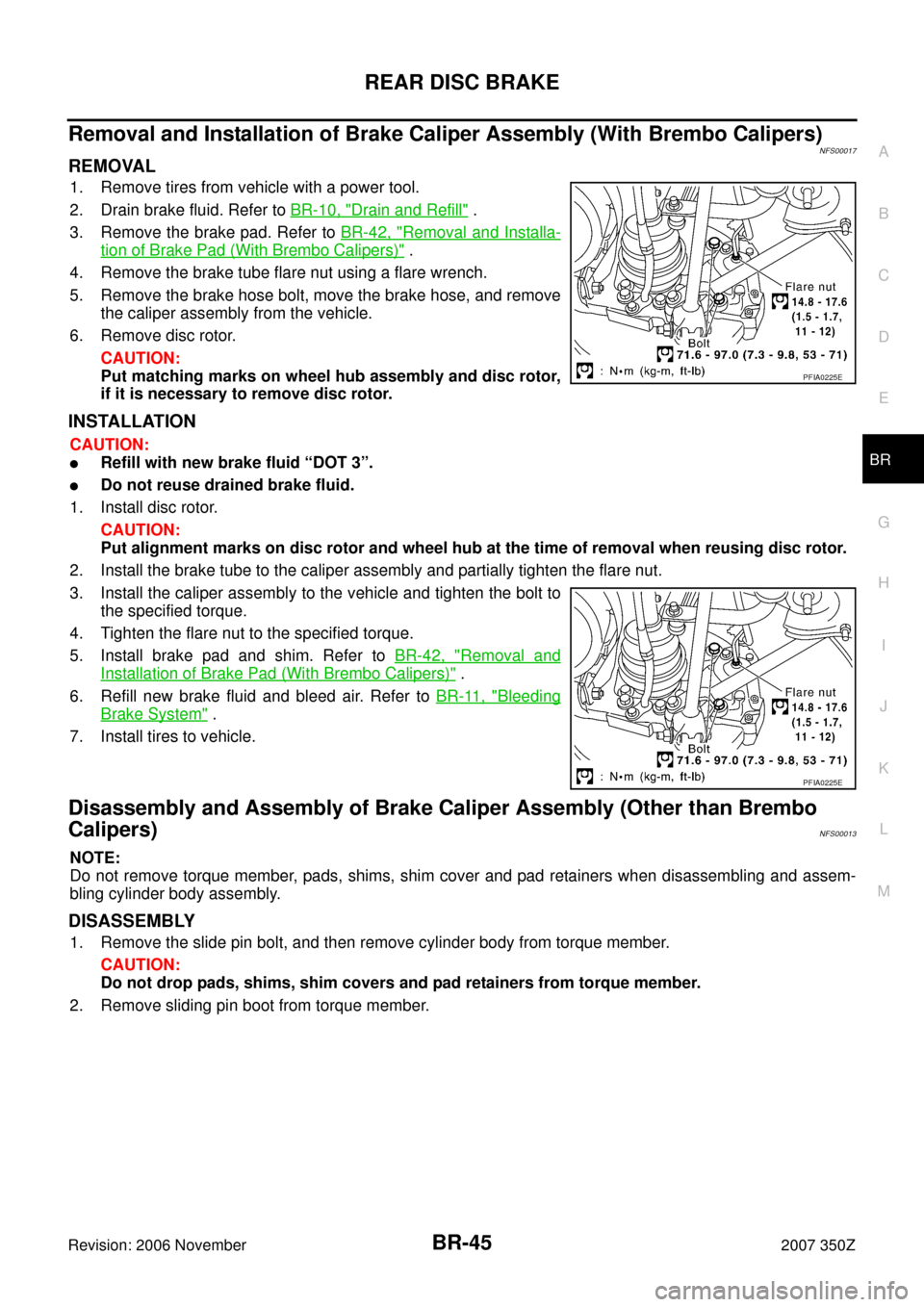
REAR DISC BRAKE
BR-45
C
D
E
G
H
I
J
K
L
MA
B
BR
Revision: 2006 November2007 350Z
Removal and Installation of Brake Caliper Assembly (With Brembo Calipers)NFS00017
REMOVAL
1. Remove tires from vehicle with a power tool.
2. Drain brake fluid. Refer to BR-10, "
Drain and Refill" .
3. Remove the brake pad. Refer to BR-42, "
Removal and Installa-
tion of Brake Pad (With Brembo Calipers)" .
4. Remove the brake tube flare nut using a flare wrench.
5. Remove the brake hose bolt, move the brake hose, and remove
the caliper assembly from the vehicle.
6. Remove disc rotor.
CAUTION:
Put matching marks on wheel hub assembly and disc rotor,
if it is necessary to remove disc rotor.
INSTALLATION
CAUTION:
�Refill with new brake fluid “DOT 3”.
�Do not reuse drained brake fluid.
1. Install disc rotor.
CAUTION:
Put alignment marks on disc rotor and wheel hub at the time of removal when reusing disc rotor.
2. Install the brake tube to the caliper assembly and partially tighten the flare nut.
3. Install the caliper assembly to the vehicle and tighten the bolt to
the specified torque.
4. Tighten the flare nut to the specified torque.
5. Install brake pad and shim. Refer to BR-42, "
Removal and
Installation of Brake Pad (With Brembo Calipers)" .
6. Refill new brake fluid and bleed air. Refer to BR-11, "
Bleeding
Brake System" .
7. Install tires to vehicle.
Disassembly and Assembly of Brake Caliper Assembly (Other than Brembo
Calipers)
NFS00013
NOTE:
Do not remove torque member, pads, shims, shim cover and pad retainers when disassembling and assem-
bling cylinder body assembly.
DISASSEMBLY
1. Remove the slide pin bolt, and then remove cylinder body from torque member.
CAUTION:
Do not drop pads, shims, shim covers and pad retainers from torque member.
2. Remove sliding pin boot from torque member.
PFIA0225E
PFIA0225E
Page 46 of 54
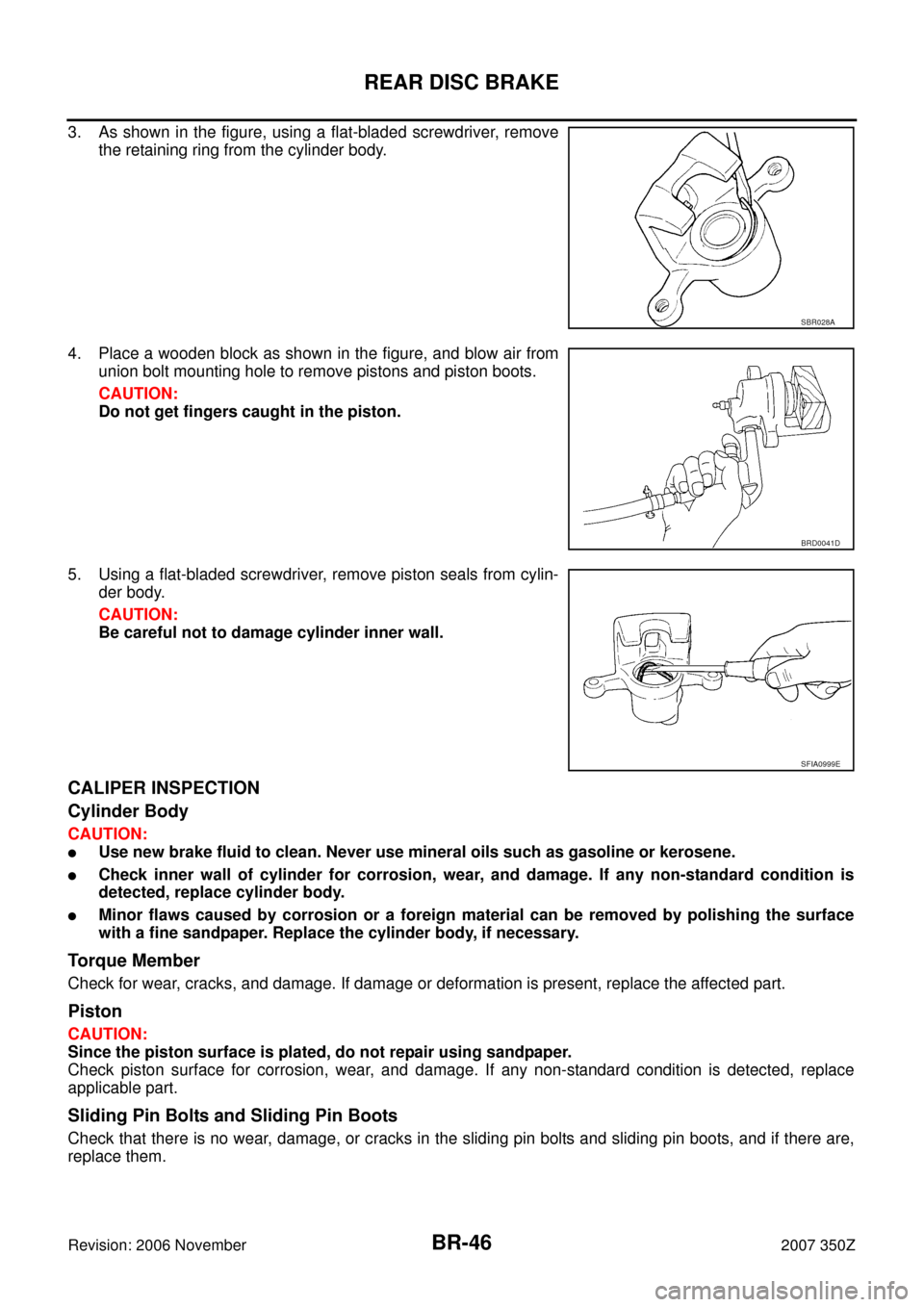
BR-46
REAR DISC BRAKE
Revision: 2006 November2007 350Z
3. As shown in the figure, using a flat-bladed screwdriver, remove
the retaining ring from the cylinder body.
4. Place a wooden block as shown in the figure, and blow air from
union bolt mounting hole to remove pistons and piston boots.
CAUTION:
Do not get fingers caught in the piston.
5. Using a flat-bladed screwdriver, remove piston seals from cylin-
der body.
CAUTION:
Be careful not to damage cylinder inner wall.
CALIPER INSPECTION
Cylinder Body
CAUTION:
�Use new brake fluid to clean. Never use mineral oils such as gasoline or kerosene.
�Check inner wall of cylinder for corrosion, wear, and damage. If any non-standard condition is
detected, replace cylinder body.
�Minor flaws caused by corrosion or a foreign material can be removed by polishing the surface
with a fine sandpaper. Replace the cylinder body, if necessary.
To r q u e M e m b e r
Check for wear, cracks, and damage. If damage or deformation is present, replace the affected part.
Piston
CAUTION:
Since the piston surface is plated, do not repair using sandpaper.
Check piston surface for corrosion, wear, and damage. If any non-standard condition is detected, replace
applicable part.
Sliding Pin Bolts and Sliding Pin Boots
Check that there is no wear, damage, or cracks in the sliding pin bolts and sliding pin boots, and if there are,
replace them.
SBR028A
BRD0041D
SFIA0999E
Page 47 of 54
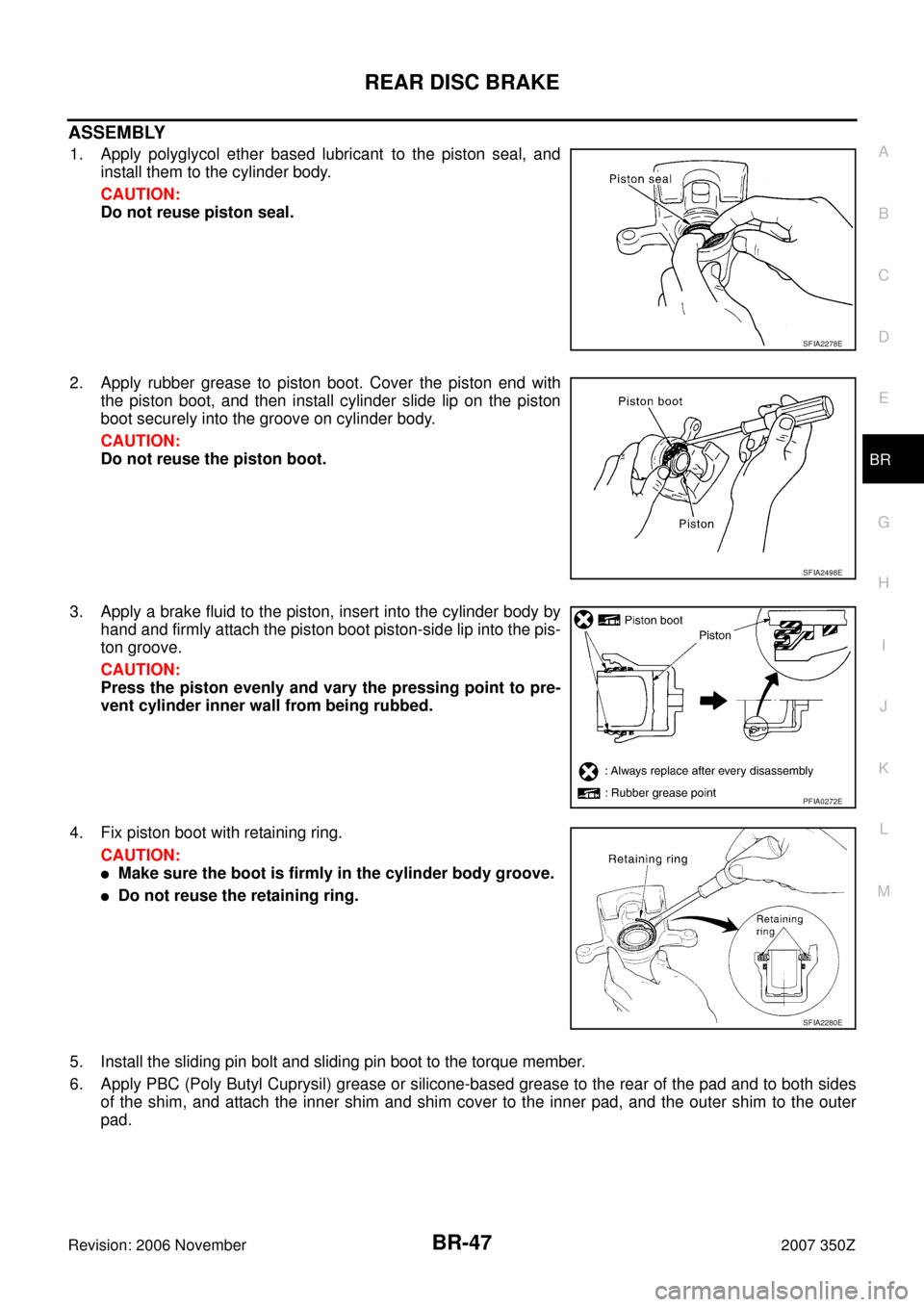
REAR DISC BRAKE
BR-47
C
D
E
G
H
I
J
K
L
MA
B
BR
Revision: 2006 November2007 350Z
ASSEMBLY
1. Apply polyglycol ether based lubricant to the piston seal, and
install them to the cylinder body.
CAUTION:
Do not reuse piston seal.
2. Apply rubber grease to piston boot. Cover the piston end with
the piston boot, and then install cylinder slide lip on the piston
boot securely into the groove on cylinder body.
CAUTION:
Do not reuse the piston boot.
3. Apply a brake fluid to the piston, insert into the cylinder body by
hand and firmly attach the piston boot piston-side lip into the pis-
ton groove.
CAUTION:
Press the piston evenly and vary the pressing point to pre-
vent cylinder inner wall from being rubbed.
4. Fix piston boot with retaining ring.
CAUTION:
�Make sure the boot is firmly in the cylinder body groove.
�Do not reuse the retaining ring.
5. Install the sliding pin bolt and sliding pin boot to the torque member.
6. Apply PBC (Poly Butyl Cuprysil) grease or silicone-based grease to the rear of the pad and to both sides
of the shim, and attach the inner shim and shim cover to the inner pad, and the outer shim to the outer
pad.
SFIA2278E
SFIA2498E
PFIA0272E
SFIA2280E
Page 49 of 54
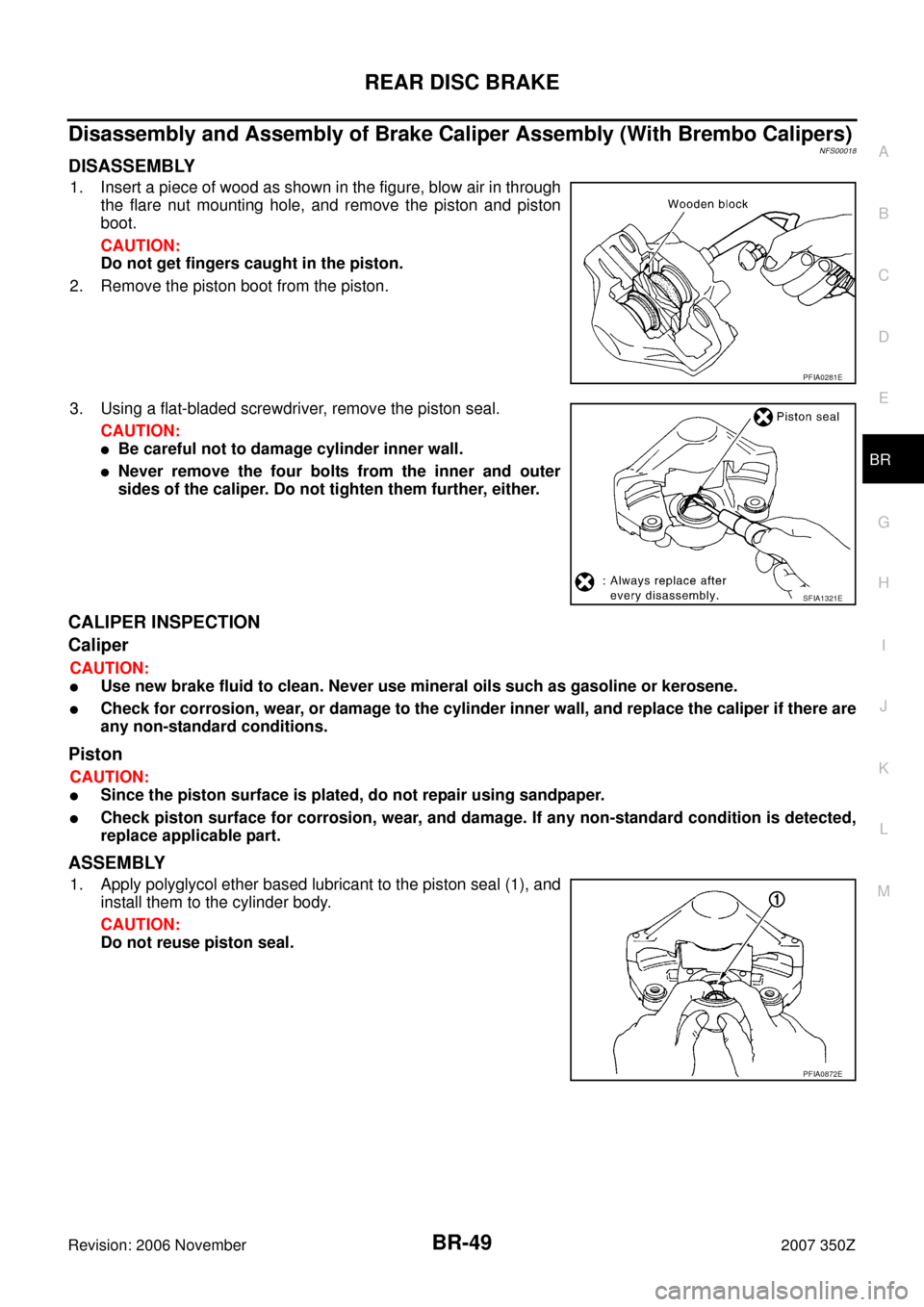
REAR DISC BRAKE
BR-49
C
D
E
G
H
I
J
K
L
MA
B
BR
Revision: 2006 November2007 350Z
Disassembly and Assembly of Brake Caliper Assembly (With Brembo Calipers)NFS00018
DISASSEMBLY
1. Insert a piece of wood as shown in the figure, blow air in through
the flare nut mounting hole, and remove the piston and piston
boot.
CAUTION:
Do not get fingers caught in the piston.
2. Remove the piston boot from the piston.
3. Using a flat-bladed screwdriver, remove the piston seal.
CAUTION:
�Be careful not to damage cylinder inner wall.
�Never remove the four bolts from the inner and outer
sides of the caliper. Do not tighten them further, either.
CALIPER INSPECTION
Caliper
CAUTION:
�Use new brake fluid to clean. Never use mineral oils such as gasoline or kerosene.
�Check for corrosion, wear, or damage to the cylinder inner wall, and replace the caliper if there are
any non-standard conditions.
Piston
CAUTION:
�Since the piston surface is plated, do not repair using sandpaper.
�Check piston surface for corrosion, wear, and damage. If any non-standard condition is detected,
replace applicable part.
ASSEMBLY
1. Apply polyglycol ether based lubricant to the piston seal (1), and
install them to the cylinder body.
CAUTION:
Do not reuse piston seal.
PFIA0281E
SFIA1321E
PFIA0872E
Page 50 of 54
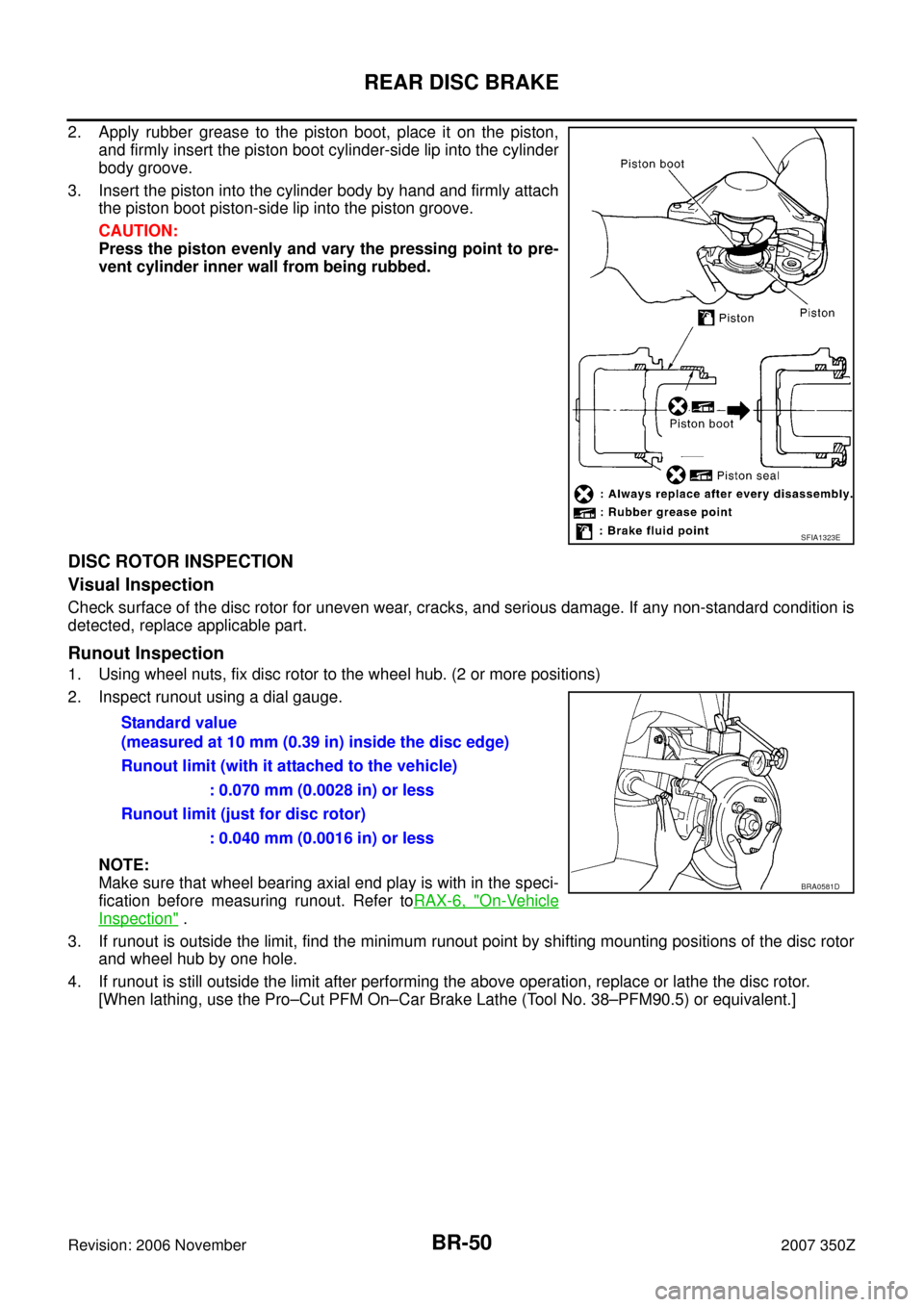
BR-50
REAR DISC BRAKE
Revision: 2006 November2007 350Z
2. Apply rubber grease to the piston boot, place it on the piston,
and firmly insert the piston boot cylinder-side lip into the cylinder
body groove.
3. Insert the piston into the cylinder body by hand and firmly attach
the piston boot piston-side lip into the piston groove.
CAUTION:
Press the piston evenly and vary the pressing point to pre-
vent cylinder inner wall from being rubbed.
DISC ROTOR INSPECTION
Visual Inspection
Check surface of the disc rotor for uneven wear, cracks, and serious damage. If any non-standard condition is
detected, replace applicable part.
Runout Inspection
1. Using wheel nuts, fix disc rotor to the wheel hub. (2 or more positions)
2. Inspect runout using a dial gauge.
NOTE:
Make sure that wheel bearing axial end play is with in the speci-
fication before measuring runout. Refer toRAX-6, "
On-Vehicle
Inspection" .
3. If runout is outside the limit, find the minimum runout point by shifting mounting positions of the disc rotor
and wheel hub by one hole.
4. If runout is still outside the limit after performing the above operation, replace or lathe the disc rotor.
[When lathing, use the Pro–Cut PFM On–Car Brake Lathe (Tool No. 38–PFM90.5) or equivalent.]
SFIA1323E
Standard value
(measured at 10 mm (0.39 in) inside the disc edge)
Runout limit (with it attached to the vehicle)
: 0.070 mm (0.0028 in) or less
Runout limit (just for disc rotor)
: 0.040 mm (0.0016 in) or less
BRA0581D